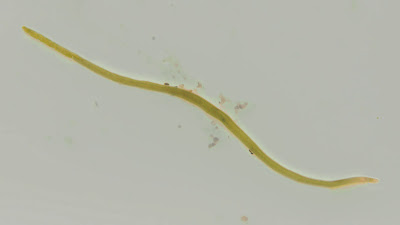Almost two years ago, on the last long weekend of the summer of 2010, we joined the crowds on and around Boundary Bay. Luckily, the tide was at its lowest; we walked out to the edge of the water, and waded in. I picked up an old clam shell loaded down with barnacles, found it full of life, and brought it home.
But it was a busy time for us; I was still catching up with photos from Campbell River, there was my
trip to Bella Coola, and afterwards, parties to go to, more beaches to visit. Somehow, the clamshell and its passengers got set aside for "later".
Now it's later.
 |
| Messy, heavy, clam shell |
 |
| It was welded half open by barnacles. |
 |
| This is why it's heavy; it's swarming with critters inside. Visible at first glance; a whelk, snails, and hermit pincers. |
 |
| The whelk. A hungry predator, busy decimating the population. |
At home, I pried the shell open and washed out its residents. There were more than I'd bargained for: the whelk, a few mud snails, slipper snails, trophon snails, assorted worms, several grainy hand hermit crabs, and a colony of what I think are probably tunicates: all crowded in, crawling over and under each other, higgledy-piggledy.
 |
| This poor little hermit has chosen the wrong mud snail shell. It is so encrusted with barnacles that he can barely walk on a smooth surface. Here he is, suffering, in a bowl. Once I'd put him in the aquarium, he was fine. |
 |
| Another grainy hand hermit. This one is carrying a large slipper snail, probably a female; the smaller one attached to her would be a male. |
All hooked slipper snails begin life as males and later become females. Smaller males may stack themselves on top of females. (Beachwatchers, WSU)
 |
| A fifteen-scaled worm, Harmothoe. possibly imbricata. These are predatory; in the clamshell, they had a nice source of living meat. |
 |
| The green polychaete, cleaned up a bit to show the parapodia (feet or paddles) with their bristles. This was a small one, about an inch long. |
The area where the clamshell lay was sandy, with a light layer of seaweeds and eelgrass, but not many small critters were apparent. The clamshell provided shelter for the hermits, snails and barnacles, and this had attracted quite the collection of predators; I was surprised at their number and variety.
Oh, but that's not all! I'm still working on identifying the mystery animals; I'll post them tomorrow, named or not.
And here are a few more of those baby shrimps, picked up the same day, but in a tidepool further up the beach.
 |
| Five or six shrimp and an amphipod, in a bowl of water. The floating debris serves as camouflage; the shrimp eyes mimic dots of rotting seaweed. |







She's got the whole world in her hand ...
ReplyDeleteSorry, couldn't pass it up. - Margy
Do you use fresh or salt water for rinsing?
ReplyDeleteAnnie; salt water. I usually bring some home with me, or I can mix up a batch of artificial sea water if I need to.
ReplyDeleteThanks. I think I would do it that way too.
ReplyDeleteWhat a wonderful clam to find!